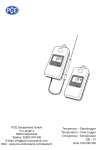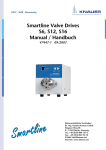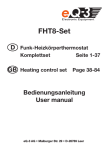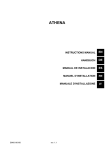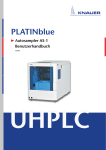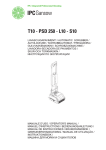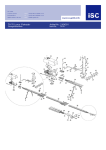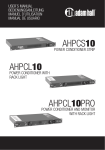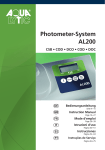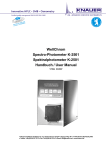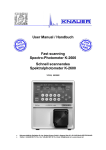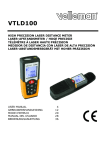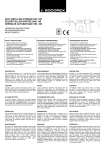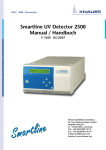Download Smartline UV Detector 200 Manual / Handbuch
Transcript
Smartline UV Detector 200 Manual / Handbuch V 7021-1 09/2007 Wissenschaftliche Gerätebau Dr. Ing. Herbert Knauer GmbH Hegauer Weg 38 D - 14163 Berlin, Germany Tel.: +49 (0)30 809 727 0 Fax.: +49 (0)30 801 50 10 E-Mail: [email protected] Internet: www.knauer.net 1 CONTENTS Using this Manual Conventions in this manual SOPs in this manual General Description Optical path of the Smartline UV Detector 200 Preparing the Smartline UV Detector 200 for Operation Unpacking Standard Delivery List Power supply Front View of the Smartline UV Detector 200 Foil Key Functions Rear Panel View of the Smartline UV Detector 200 Installation of the flow cell Capillary Connection to a HPLC System Connecting other Instruments with the UV-Detector 200 Terminal Strip Assembling Plug Strips Smartline UV Detector 200 in software controlled HPLC systems Simple Maintenance Check of the Mercury Lamp functions Changing the Mercury Lamp Cleaning the Flow Cell Changing the Measurement Path Length Errors that can occur on the Display Technical Data Spare Parts and Accessories Available Flow Cells for the Smartline UV Detector 200 Spare Parts Warranty statement Declaration of conformity 3 3 3 4 4 5 5 5 5 6 6 7 7 7 9 9 10 11 11 11 12 12 14 14 15 16 16 16 31 32 2 INHALT Hinweise zum Gebrauch des Handbuchs Konventionen in diesem Handbuch SOP’s in diesem Handbuch Allgemeine Beschreibung Optischer Weg im Smartline UV Detector 200 Inbetriebnahme des Smartline UV Detector 200 Auspacken Lieferumfang Stromversorgung Frontansicht des Smartline UV Detector 200 Funktion der Folientasten Rückansicht des Smartline UV Detector 200 Installation der Messzelle Kapillaranschluss an ein HPLC-System Verbindung anderer Geräte mit dem Smartline UV Detector 200 Fernsteuerungsleiste Montage der Anschlussstecker Smartline UV Detector 200 im Softwarebetrieb Einfache Wartung Kontrolle der Lampenfunktion Lampenwechsel Messzellenreinigung Veränderung der Messweglänge Liste der Displaymeldungen Technische Daten Ersatzteile und Zubehör Messzellen für der Smartline UV Detector 200 Ersatzteile und Zubehör, Bestellnummern Garantiebedingungen Konformitätserklärung 17 17 17 18 18 19 19 19 19 20 20 21 21 21 23 24 24 25 26 26 26 26 28 29 29 30 30 30 31 32 Using this Manual 3 Using this Manual This manual refers to the Smartline UV Detector 200 Firmware Revision 3.01 or higher. It is valid for any combination with analytical flow cells order number A 4061, A 4062, A 4063, A 4065, preparative flow cells order number A 4066, A 4067, A 4068, A 4069 and all UZ View™ micro flow cells in standard. Conventions in this manual Important Hints are marked by the marginal hand symbol. Special warnings are indicated by the marginal warning sign and printed in bold letters. The marginal lamp symbol indicates helpful advice’s. SOPs in this manual The Standard Operating Procedures (SOP) provided with this manual offer a convenient way of structuring complex tasks in the operation of your Smartline UV Detector 200. They include step-by-step instructions leading the user through all routine tasks during operation. They can be used for documentation purposes and be copied, applied signed, and filed in order to document the performance of the instrument. Please operate the instrument and all accessories according to instructions and SOPs in this manual. This ensures proper results and longevity of your equipment. SOP 1 SOP 2 SOP 3 SOP 4 SOP 5 SOP 6 SOP 7 SOP 8 SOP 9 Installation of the flow cell Capillary connections. Assembling WAGO Plug Strips Assembling Plug Strips for an Assistant 6000 Changing the Mercury Lamp Purging the Flow Cell Cleaning an analytical flow cell. Cleaning a preparative flow cell Changing the Measurement Path Length 7 7 10 10 12 12 13 13 14 4 General Description General Description The Smartline UV Detector 200 is equipped with a Mercury lamp that enables measurements at 254nm. The most intensive line of the mercury spectrum is located at 254nm. Through this physical constant it is no longer necessary to check the accuracy of the wavelength of the detector. The device is characterized by its very simple operation. It possesses only three keys which are: to adjust the measuring range, the time constant, and to trigger the Autozero. The device is ideally suited for the stand-alone-operation as well as for use in a complete system that is controlled by a Knauer HPLC software System: ChromGate® (Version 3.1.7 or higher), EuroChrom®, or ClarityChrom® (with interface). The UV Detector SMARTLINE UV DETECTOR 200 can collect data digitally by directly connecting the device to a PC or laptop. This ensures that the device will automatically collect data without the need for manual input. A recorder or integrator can also be connected to the UV Detector SMARTLINE UV DETECTOR 200. A low noise level (≤ 3 x 10-5 AU) as well as a slight base line drift (≤ 2,5 x 10-4 AU/h) is a characteristic of the detector. Like in all other UV-Detectors of the Smartline-Series, access to the flow cell is configured to be user friendly. The photometer is very flexible in the sense that it can be installed in several different areas of LC applications. The wide range varies from flow cells for the Knauer photometer, to the nano-HPLC-Cells with flow rates of > 100nl/min, up to the preparative flow cells with 10 l/min. The UV-Detector 200 as well as the Pump S 100and/or the valve drives S 6/12/16 can be an integrative part of the Smartline Assistant 6000. Up to three of these instruments can be placed in one Smartline housing. Thus, even a whole HPLC system can be put into one modul. Optical path of the Smartline UV Detector 200 1 7 6 4 3 2 1. 2. 3. 4. 5. 6. 7. Mercury vapor lamp Plan mirror Interference filter 254nm Semi transparent mirror Reference diode Flow cell Photodiode 5 Fig. 1 Optical path of the Smartline UV Detector 200 The light emitted from the lamp (1) is rerouted by a mirror (2). After passing a filter (3) the beam is split by a semi transparent mirror (4). One beam gives a reference signal (5).The other beam is guided through the flow cell (6) were the optical absorption is measured (7). Preparing the Smartline UV Detector 200 for Operation 5 Preparing the Smartline UV Detector 200 for Operation Unpacking After unpacking, please check the device and accessories thoroughly for any damage that may have occurred during transportation. If necessary, contact the carrier to claim any damages. Use the “Standard delivery list“ to check if the Smartline UV Detector 200 is complete. Please contact our service department if anything is missing or if you need support. It is important to fill out the guarantee card and return it to us as soon as possible. Standard Delivery List Smartline UV Detector 200 with Power Supply, without Flow Cell User Manual RS-232 Cable Power Supply Unit Integrator Cable 2-pin Plug Terminal Strip Power supply The Smartline UV Detector 200 is equipped with a universal power supply which operates in a range of 90 to 260 Volts AC. A manual setting of the supply voltage is, therefore, not required. Make sure that the main power supply is properly grounded and the correct power cable is used. Please connect the power supply to the device. Then connect the power cable to the power supply and the socket. The power supply for the Smartline UV Detector 200 is not included in the housing. After switching it on you will see the version of the internal software on the display (e.g. 3.01 for a few seconds). The lamp of the device is heated up to a constant working temperature. After approximately ten minutes you can start measurement. 6 Preparing the Smartline UV Detector 200 for Operation Front View of the Smartline UV Detector 200 1. 2. 3. 4. 5. 6. 7. 8. 9. 1 Display Foilpad Knurled cell screws Flow cell housing Flow cell cradle Outlet Flow cell Path length of cell Inlet 2 3 4 5 10 9 Fig. 2 8 7 6 Front panel of the Smartline UV Detector 200 and flow cell Foil Key Functions RANGE KEY Depending on the given signal of the detector, it can be interpreted as the following: 1V = 1AU, 0,1AU or 0,01AU If the button is shortly pushed, a preset value of the scale will appear. If the button is pushed for longer that two seconds, then the value can change by pushing the button one more time. The different scales will be affected on the display as well as on the integrator output . The digital recording will remain uninfluenced. TIME CONSTANT Using the time constant t: you can achieve a signal smoothing. It’s value can be set to 0.05, 0.2, 1, 2, or 5 seconds. The larger this value is set the more the signal will be smoothed. A time constant of one second fits most of analytical purposes best. If the button is shortly pushed (< 2s) a preset value of the scale will appear. If the button is pushed for longer that two seconds then the value can changed by pushing the button one more time. Autozero Pushing this button will perform an adjustion of the baseline. Usually the button should be pressed shortly before starting a chromatographic run. If digital data are transmitted this button will become blocked. Preparing the Smartline UV Detector 200 for Operation 7 Rear Panel View of the Smartline UV Detector 200 1. Analog output 2. RS-232 Interface 3. Terminal strip Remote connections 4. 24 V – Power connector Fig. 3 Rear panel elements of the Smartline UV Detector 200 Installation of the flow cell The Smartline UV Detector 200 comes factory configured without a flow cell. However, in the Chance HPLC System it is included. The device is equipped with a "dummy" cell which does not have any optical parts. Before operating the photometer it is necessary to install an appropriate KNAUER flow cell. SOP 1 Installation of the flow cell This instruction refers to the Smartline UV Detector 200. First, loosen the two “knurled cell screws“ and remove them. Pull out the “flow cell housing“. Take the dummy cell with two fingers and remove it upward. Insert the new “Flow cell“ and make sure the engraved specifications point towards the user. The fixing hole on the back side of the cell fits with the corresponding metal pin of the photometer’s housing. Finally, push the “Flow cell cradle“ with the flow cell towards the housing, insert the two screws and tighten them manually. Capillary Connection to a HPLC System Before taking a measurement cell filled with fluid into operation, please make certain that the used eluent is miscible with that one used previously. Otherwise purge the flow cell with a medium miscible with both the other fluids. SOP 2 Capillary connections. This instruction refers to the Smartline UV Detector 200. 1. Connect the outlet of the HPLC column to the inlet bushing of the flow cell (9). Please use DYNASEAL bushings and the shortest possible capillary with small internal diameter in order to keep the dead volume as small as possible. 2. Push the bushing, the clamping ring, and the sealing ring onto the capillary. Please take care on the sequence and orientation of fittings, see Fig. 4 „DYNASEAL Capillary connections“. 8 Preparing the Smartline UV Detector 200 for Operation 3. Push the capillary as far as possible into the flow cell input. 4. Fasten the bushing by hand. 5. Connect the flow cell outlet (6) using a capillary or teflon tube (ID > 0,5 mm) to a waste bottle. Injection Valve Column Flow Cell Outlet Flow Cell Inlet Sealing Ring Clamping Ring Fig. 4 DYNASEAL Capillary connections The capillary in a simple isocratic system is shown in the following figure. For perspective reasons the UV Smartline UV Detector 200 is symbolized by the flow cell and the used HPLC pump by it’s pump head. Column Pump Head Sample Waste Flow Cell Waste Fig. 5 Isocratic HPLC System Eluent Connecting other Instruments with the UV-Detector 200 9 Connecting other Instruments with the UV-Detector 200 The UV-Detector 200 as well as the Pump S 100and/or the valve drives S 6/12/16 can be an integrative part of the Smartline Assistant 6000. Up to three of these instruments can be placed in one Smartline housing. Thus, even a whole HPLC system can be put into one modul. 1 Fig. 6 2 3 Front view of the Smartline Assistant 6000 (A5003V065), with: 1 Smartline UV Detector 200, 2 Smartline Pump 100 and 3 injection valve (manual) The GPC Sample Preparation Unit 6500 (Fig. 7) is another example. It consists of a Smartline Pump 1000 and two versions of the Smartline Assistant 6000. The Smartline UV Detector 200 is integrated in the Assitant version V416. 2 1 3 Fig. 7 Front view of the Smartline Assistant 6000 (A5003V416), with: 1 Smartline UV Detector 200 2 6-Port-2-channel injection valve and 3 13-Port-1- channel switching valve for fraction collection Terminal Strip The terminal strip on the rear side of the Smartline UV Detector 200 serves for sending and receiving signals to or from another instrument. Please avoid touching the electrical contacts of the socket lines. Electrostatic discharges when touching the contacts can damage the sensitive electronics of the device. 10 Connecting other Instruments with the UV-Detector 200 Remote Autozero In the “stand alone“ mode a remote AUTOZERO can be carried out when the contact between the AUTOZERO-pin and the GROUND-pin is short circuited. Assembling Plug Strips The electrical connections mentioned below can be mounted as follows: (The plug strip with two connectors is enclosed with the accessories) 2 lever 1 4 plug strip Fig. 8 SOP 3 3 cable Assembling WAGO Plug Strips Assembling WAGO Plug Strips 1. Insert the rounded end of the lever latch into the square opening of the selected connector of the plug strip. 2. Press the latch down as indicated by the arrow. 3. Insert the uninsulated end of the cable into the opening under the catch. 4. Release the latch and remove the lever latch (1) from the plug making sure the cable is firmly anchored in the plug strip. If the detector is part of an Assistant 6000 all connectors are situated at the rear of this instrument. In this case the WAGO connector is of different shape. The mounting of the strip is verry similar.. SOP 4 Assembling Plug Strips for an Assistant 6000 1. Press down the cable clip as shown in Fig. 9 using a small srew driver or the WAGO liner tool. 2. Insert the uninsulated end of the cable into the opening under the latch. 3. Remove the tool from the plug. The cable is now firmly anchored in the plug strip. Simple Maintenance Fig. 9 11 Mounting plug strips Smartline UV Detector 200 in software controlled HPLC systems The Smartline UV Detector 200 can be integrated into KNAUER-software (ChromGate, EuroChrom or ClarityChrom) controlled HPLC systems. For signal read out the detector has to be directly connected to the PC with a RS232-cable. While operating software controlled it is necessary to transmit a start signal from the injection valve to initiate the data acquisition. This can be done by connecting both of the injection valve cables to the autozero and ground contact, see Fig. 3 on page 7. The data read out is also possible with elder versions of EuroChrom®. In this case it is to be integrated into the hardware description as a K-200 detector. The control signals of the WellChrom Detector K-200 are also part of the UV-Detector 200 firmware. Interface protocol For data acquisition with the Smartline UV-Detector 200 and a nonKNAUER software via RS-232 you can get the interface protocol from KNAUER upon request. Simple Maintenance Check of the Mercury Lamp functions The mercury lamp in the Smartline UV Detector 200 guarantees reliable measurements with a low noise level and a low base line drift as well as a high sensitivity. The actual life of the mercury lamp is dependent on various influences. A few examples of these influences are: the number of times the lamp is ignited, the average duration of time that the lamp is on, or the customers demands with respect to noise level and sensitivity. The lifespan of the mercury lamp compared to the Deuterium lamp is several times longer. If increasing noise or recessive sensitivity is observed with the Smartline UV Detector 200 then it is time to replace the mercury lamp. 12 Simple Maintenance Changing the Mercury Lamp Remove the power plug before opening the detector. Be sure to let the lamp cool down for at least 10 minutes after switching it off. SOP 5 Changing the Mercury Lamp This instruction refers to the Smartline UV Detector 200. 1. Loosen the screws on the housing and remove them. 2. The lamp is soldered to the circuit board. The circuit board is on the right side behind the mounting of the flow cell. Loosen both of the lamp socket screws that are affixed to the circuit board. 3. Take the light circuit board out of the device. 4. Plug the lamp plug into the new circuit board. 5. Insert the new lamp circuit board and tighten all the screws. 6. Replace the housing cover and the screws. Cleaning the Flow Cell A noisy baseline and low sensitivity may be due to a dirty flow cell lens. In most cases it is sufficient to purge the flow cell according to the following SOP. SOP 6 Purging the Flow Cell 1. Purge the flow cell using one of following solvents: sodium dodecyle sulfate (SDS), 1m HCl, 1m NaOH, ethanol, or acetone. 2. Run the solvent through the flow cell using a syringe and leave for approximately 5 minutes.. 3. Rinse extensively with water and the blow dry using a gentle stream of pure nitrogen. Never dry with compressed air from a „house“ line as this will contain microdroplets of oil that will coat the cell. When the optics module is not in use, disconnect the flow cell and clean out traces of salt and protein with a syringe filled with distilled water. Before storing the flow cell inject a dilute solution (10-25%) of ethanol or i-propanol to prevent microbial growth. In case the flow cell purging does not provide sufficient results, all flow cells can easily be disassembled for cleaning. Analytical flow cells Outer thread Gasket Lens PTFE Seal Fig. 10 Sectional view of an analytical flow cell Simple Maintenance SOP 7 13 Cleaning an analytical flow cell. This instruction applies to the analytical flow cells A4061, A4062, A4063, and A4065. 1. Unscrew the outer threads with the 3 mm hexagonal spanner (enclosed in the flow cell’s delivery). 2. Remove the black gasket mounting of the lenses with a pair of tweezers or by gently tapping it on a clean surface. The lens is embedded in the gasket mounting and sealed against the flow path with a perfluorated hydrocarbons (PTFE) seal. This seal should be changed every time the flow cell is disassembled. 3. Take out the lenses and clean them by wiping them with a soft cloth or an appropriate solvent in an ultrasonic bath. Be careful not to touch the clean lens with fingers. 4. Reassemble the cell in the reverse manner, making sure that the PTFE seal does not block the light path. 5. Tighten the outer threads carefully with the spanner to avoid damaging the lenses. Preparative flow cells Screw thread Washer PEEK distance plate Gasket holder Light guide with PTFE seal Fig. 11 SOP 8 Sectional view of a preparative flow cell Cleaning a preparative flow cell This SOP applies to the following preparative flow cells: A4066, A4067, A4068, and A4069. 1. Unlike the concave lens in the analytical flow cells, the preparative flow cells have a rod shaped light guide. 2. Unscrew the outer thread with a hexagonal spanner. 3. Take out the stainless steel plain washer and the PEEK distance plate (not present in A4069). 4. Take out the gasket holder with the light guide by grasping the outer grooves with a pair of tweezers. 5. To clean the lens, push out the light guide and strip the PTFE sealing ring 6. Reassemble the cell in the reverse order. Each time the flow cell is disassembled use a new PTFE ring to ensure the consistency of the flow cell. 14 Errors that can occur on the Display Changing the Measurement Path Length SOP 9 Changing the Measurement Path Length This description is valid for the following preparative flow cells: A4066, A4067 and A4068 with 1/8″ or 1/4″ connectors. The measurement path length can be adjusted to 2; 1,25 or 0,5 mm. The measurement path length is set to 2mm when manufactured. If desired, follow the below steps to reduce the path length to 1,25 or 0,5 mm 1. Loosen the cap nut with a hexagonal head wrench. 2. Remove the stainless steel sealing ring and the PEEK spacer. 3. Replace the stainless steel ring and retighten the nut. Without a spacer the light flow will be pushed deeper into the flow cell. (0,75 mm), resulting in a reduction in the measurement path length. To reduce the measurement path length even further to 0,5 mm use the other side of the cell in analog mode. 4. To increase the measurement path length back to 0,75 mm reinsert the spacer. 5. Loosen the cap nut, remove the stainless steel sealing ring, and remove the light guide mounting with a pair of tweezers. 6. Use a clean towel to push the light guide, about 1 mm, outwards in order to increase the path length. Avoid touching the light flow with fingers. 7. Reinsert the mounting in the cell. 8. Replace the PEEK spacer and then the stainless steel ring. 9. Carefully retighten the cap nut. Tightening the cap nut will push the rod shaped light guide into the right position. Inserting the spacer increases the path length to 0,75 mm. When changing the path length it is not necessary to change the PTFE seal. Errors that can occur on the Display The following display symbols can appear while the Smartline UV Detector 200 is in operation. ¯XXX: The signal value xxxx cannot be displayed on the screen due to the fact that it is too big. Instead, choose a less sensitive measuring range (e.g. 0.1 instead of 0.01). _XXX: The signal value cannot be displayed on the screen due to the fact that it is too small. Instead, choose a more sensitive measuring range (e.g. 0.1 instead of 1). Technical Data 15 Technical Data Wavelength Lamp Lifetime of lamp Linearity Noise Base line drift Sensitivity Time constants Integrator Output Auto zero Display Control Weight Dimensions 254 nm, ∆λ 20 nm Mercury vapor lamp approx. 6000 h 0 - 2.5 AU 3 x 10-5 AU, 1.0s; 2.5 x 10-4 AU/h, 1.0s; 6 x 10-5 AU, 1.0 s 0.05 s / 0.2 s / 1.0 s / 2.0 s / 5.0 s -10V to +10V remote and manual 4 digits 1 RS 232 interface, remote socket, analog out 1.5 kg 105 x 100 x 185 mm (W x H x D) 16 Spare Parts and Accessories Spare Parts and Accessories Available Flow Cells for the Smartline UV Detector 200 Analytical Flow Cells Order No. Cell type Layer Thickness (mm); Connector ID channel (mm) Volume (µL) Material Flow Range (mL/min) Maximum Pressure (bar) A4061 10 mm; 1/16″ 1,1 10 20 300 A4042 3 mm; 1/16″ 1,0 2 stainless steel, with heat exchanger stainless steel 50 300 A4045 3 mm; 1/16″ 1,0 2 PEEK 50 30 Preparative Flow Cells A4066 0,5/1,25/2 mm 1/8″ stainless steel 1.000 200 A4067 0,5/1,25/2 mm 1/8″ PEEK 1.000 100 A4068 0,5/1,25/2 mm 1/4″ stainless steel 10.000 200 A4069 0,5 mm 1/16″ stainless steel 250 200 A4095 0,5 mm 1/16″ PEEK 250 100 U-Z View™ Micro Flow Cells A4091 8 mm 1/16″ 0,150 0,140 fused silica 0,10 500 A4092 8 mm 280 µm 0,015 0,035 fused silica 0,01 500 A4093 8 mm 280 µm 0,020 0,003 fused silica 0,001 500 Spare Parts Order No. Mercury lamp with the circuit board A4142 Repair kit for analytical flow cells A1131 Repair kit for preparative flow cells A1132 Test cell (dummy cell) A4124 Hinweise zum Gebrauch des Handbuchs 17 Hinweise zum Gebrauch des Handbuchs Dieses Handbuch bezieht sich auf den Smartline UV Detector 200 der Firmwareversion 3.01 oder höher. Es gilt für alle Kombinationen mit den analytischen Messzellen der Bestellnummern A4061, A4062, A4063, A4065, präparative Messzellen der Bestellnummern A4066, A4067, A4068, A4069 und alle ZU View™ Mikromesszellen in Standardausführung. Konventionen in diesem Handbuch Wichtige Hinweise werden in Hinweissymbol kenntlich gemacht. der Marginalspalte durch das Besondere Warnhinweise und Hinweise auf mögliche Probleme sind mit dem Warnsymbol gekennzeichnet. Ein nützlicher Tipp wird in der Marginalspalte durch das Symbol hervorgehoben. SOP’s in diesem Handbuch Die Standardarbeitsanweisungen (Standard Operating Procedures, SOP) dieses Handbuches ermöglichen die Strukturierung zusammenhängender Aufgaben beim Betrieb Ihres Smartline UV Detector 200. Sie beinhalten schrittweise Anweisungen, die den Anwender durch alle Aufgaben führen. Sie können gleichfalls zu Dokumentationszwecken genutzt werden. Sie können kopiert, angewendet, unterzeichnet und abgelegt werden, um so die Leistungsfähigkeit Ihres Gerätes zu dokumentieren. Bitte betreiben Sie das Gerät inklusive Zubehör gemäß der SOPs in diesem Handbuch. Andernfalls können fehlerhafte Messergebnisse, Beschädigungen oder gesundheitliche Beeinträchtigungen des Anwenders eintreten, obwohl dieses Gerät außerordentlich robust und betriebssicher ist. SOP 1 SOP 2 SOP 3 SOP 4 SOP 5 SOP 6 SOP 7 SOP 8 SOP 9 Installation der Messzelle Anschluss der Lösungsmittelleitung WAGO-Anschlusssteckermontage WAGO-Anschlusssteckermontage im Assistant 6000 Lampenwechsel Spülen der Messzelle Reinigung einer analytische Messzelle Reinigung einer präparativen Messzelle Veränderung der Messweglänge 21 21 24 25 26 26 27 28 28 18 Allgemeine Beschreibung Allgemeine Beschreibung Der Smartline UV Detector 200 ist mit einer Quecksiberdampflampe ausgestattet, die Messungen bei 254 nm ermöglicht. Die intensivste Linie des Quecksilberspektrums befindet sich bei 254 nm. Durch diese physikalische Konstante erübrigt sich somit die Überprüfung der Wellenlängenrichtigkeit des Detektors. Das Gerät zeichnet sich vor allem durch seine sehr einfache Bedienung aus. Es besitzt nur 3 Tasten: zur Einstellung des Messbereiches, der Zeitkonstante und zum Auslösen des Autozero. Das Gerät ist ideal geeignet sowohl für den Stand-alone-Betrieb, als auch für den Einsatz in einem kompletten System unter der Steuerung einer KNAUER HPLC Software: ChromGate® (ab Version 3.1.7), EuroChrom®, oder ClarityChrom® (mit Interface). Die Datenerfassung des Smartline UV Detector 200 kann digital erfolgen durch direktes Verbinden des Gerätes mit ihrem PC oder Laptop. Dadurch wird ein störungsfreies Arbeiten des Gerätes gewährleistet. Ein Schreiber oder Integrator kann an den Smartline UV Detector 200 auch angeschlossen werden. Den empfindlichen Smartline UV Detector 200 kennzeichnet ein niedriger Rauschpegel (≤ 3 x 10-5 AU) und ebenso geringe Basisliniendrift (≤ 2,5 x 10-4 AU/h). Wie bei allen anderen UV-Detektoren der Smartline-Serie ist der Zugang zur Messzelle anwenderfreundlich gestaltet. Eine reichhaltige Palette von Messzellen für die KNAUER Photometer, von Nano-HPLC Zellen mit Flussraten > 100 nL/min bis zu präparativen Messzellen mit 10 l/min, macht den Smartline UV Detector 200 flexibel einsetzbar in vielen Bereichen der LC Anwendungen. Der Smartline UV Detector 200 kann neben der Smartline Pumpe 100 und/oder den Smartline Ventilantrieben S 6/12/16 integrativer Bestandteil des Smartline Assistant 6000 sein. Der Assistant 6000 kann bis zu drei der genannten Einzelgeräte innerhalb eines Smartlinemoduls enthalten. Dadurch kann in einem einzigen Modul ein komplettes HPLC-System untergebracht werden. Optischer Weg im Smartline UV Detector 200 1 7 6 4 3 2 1. 2. 3. 4. 5. 6. Quecksilberlampe Umlenkspiegel Interferenzfilter 254nm Halbtransparenter Spiegel Referenzdiode Messzelle 7. Photodiode 5 Abb. 1 Optischer Weg im Smartline UV Detector 200 Das von der Lampe (1) emittierte Licht wird durch einen Spiegel (2) umgelenkt durch ein Interferenzfilter (3) geleitet. Danach wird der Strahl durch einen halbtransparenten Spiegel (4) geteilt. Ein Strahl liefert das Referenzsignal (5). Der andere wird durch die Messzelle (6) geleitet, wo die optische Absorption gemessen wird (7). Inbetriebnahme des Smartline UV Detector 200 19 Inbetriebnahme des Smartline UV Detector 200 Auspacken Alle KNAUER-Geräte werden ab Werk sorgfältig und sicher für den Transport verpackt. Prüfen Sie dennoch nach dem Auspacken alle Geräteteile und das Zubehör auf mögliche Transportschäden und machen Sie ggf. Schadenersatzansprüche sofort beim Transportunternehmen geltend. Bitte überprüfen Sie anhand der Packliste das Zubehör auf Vollständigkeit. Sollte trotz unserer sorgfältigen Ausgangskontrollen ein Teil fehlen, wenden Sie sich bitte an unsere Serviceabteilung. Lieferumfang Smartline UV Detector 200 mit Netzteil, ohne Messzelle Handbuch RS-232 Kabel Netzkabel Integratorkabel 2-polige Steckerleiste Stromversorgung Der Smartline UV Detector 200 hat eine universelle Stromversorgung, die im Bereich von 90 bis 260 Volt Wechselstrom arbeitet. Eine manuelle Einstellung entsprechend der örtlich anliegenden Spannung ist deshalb nicht erforderlich. Stellen Sie sicher, dass der Netzanschluss vorschriftsmäßig geerdet ist und ein entsprechendes Netzkabel verwendet wird. Das Netzteil des K-200 Detektors ist nicht in dessen Gehäuse integriert. Es arbeitet ohne manuelle Umschaltung an jeder Steckdose von 90 bis 240 Volt. Verbinden Sie das Netzteil mit dem 24V-Eingang auf der Rückseite des Detektors. Anschließend das Netzkabel mit dem Netzanschluss. Nach dem Einschalten erscheinen auf dem Display, siehe 1 in Abb. 2, die Version der internen Software, wie 3.01. Danach heizt sich die Lampe auf die konstante Arbeitstemperatur auf. Das Gerät ist nach ca. 10 Minuten messbereit. 20 Inbetriebnahme des Smartline UV Detector 200 Frontansicht des Smartline UV Detector 200 1 1. Display 2. Folientasten 3. Rändelschrauben zur Messzellenbefestigung 4. Messzellengehäuse 5. Messzellenhalterung 6. Messzellenausgang 7. Messzelle 8. Schichtdicke 9. Messzelleneingang 2 3 4 5 10 9 Abb. 2 8 7 6 Frontansicht des Smartline UV Detector 200 und der Messzelle Funktion der Folientasten Siehe Folientasten (2) in Abb. 2 „Frontansicht des K-200 UV Detektors“. Range-Taste Das ausgegebene Signal des Detektors (1V) kann - abhängig von der gewählten Einstellung - folgenderweise interpretiert werden,: 1V = 1AU, 0,1AU oder 0,01AU Wird die Taste kurz gedrückt erscheint der voreingestellte Wert der Skalierung. Wird die Taste länger als 2s gedrückt, kann der Wert verändert werden durch erneuertes Drücken der Taste. Die unterschiedlichen Skalierungen wirken sich sowohl auf die Anzeige am Display als auch auf den Intgratorausgang aus. Die digitale Datenaufnahme bleibt davon unbeeinflusst. Zeitkonstante Mit Hilfe der Zeitkonstsante kann eine Signalglättung bewirkt werden. Sie können Werte zwischen 0,05; 0,2; 1; 2 und 5 Sekunden auswählen. Je größer der Wert der Zeitkonstante ist, um so stärker wird das Signal geglättet. Für die meisten analytischen Zwecke ist eine Zeitkonstante von 1s am besten geeignet. Wird die Taste kurz gedrückt (< 2s) wird der voreingestellte Wert angezeigt. Wird die Taste länger als 2s gedrückt kann der Wert der Skalierung verändert werden. Autozero Diese Taste dient zum automatischen justieren der Basislinie. Die Taste wird in der Regel vor Beginn einer Chromatogramm-Aufzeichnung kurz gedrückt. Werden digital Daten übertragen, ist diese Taste blockiert. Inbetriebnahme des Smartline UV Detector 200 21 Rückansicht des Smartline UV Detector 200 1. Integratoranschluss 2. RS-232 Anschluss 3. Fernsteuerungsleiste (Autozero- bzw. Injektionsventil-Anschluss) 4. 24 V – Spannungseingang vom Abb. 3 Rückansicht des Smartline UV Detector 200 Installation der Messzelle Die Lieferkonfiguration des Smartline UV Detector 200 beinhaltet keine Messzelle. Das Gerät wird mit einer sogenannten Dummyzelle ausgeliefert, die kein Linsensystem beinhaltet und mit der Durchflussmessungen nicht möglich sind. Vor dem Einsatz des Smartline UV Detector 200 muss eine aus der Palette der von KNAUER lieferbaren Messzellen installiert werden. SOP 1 Installation der Messzelle 1. Die Anweisung gilt für den Smartline UV Detector 200. 2. Lösen und entfernen Sie die beiden Rändelschrauben (3) von Hand. 3. Ziehen Sie das Messzellengehäuse heraus. 4. Nehmen Sie die darin befindliche Zelle oder Dummyzelle mit zwei Fingern nach oben heraus. 5. Führen Sie die neue Messzelle (7) ein und vergewissern Sie sich, dass die eingravierte Spezifikation zu Ihnen zeigt und der Metallstift des Photometergehäuses in die entsprechende Fixierungsöffnung auf der Rückseite der Zelle passt. 6. Schieben Sie nun das gesamte System an das Gehäuse, führen die beiden Schrauben ein und ziehen diese manuell fest. Kapillaranschluss an ein HPLC-System Wenn Sie eine flüssigkeitsgefüllte Messzelle in Betrieb nehmen, vergewissern Sie sich bitte, dass das benutzte Lösungsmittel mit dem vorher verwendeten mischbar ist. Anderenfalls führen Sie bitte eine Zwischenspülung mit einem mit beiden Flüssigkeiten mischbaren Medium aus. SOP 2 Anschluss der Lösungsmittelleitung Die folgende Anweisung gilt für den Smartline UV Detector 200. 1. Verbinden Sie den Ausgang der HPLC-Säule mit der Eingangsverschraubung der Messzelle (links oben). 22 Inbetriebnahme des Smartline UV Detector 200 Verwenden Sie hierfür DYNASEAL-Verschraubungen und zur Minimierung des Totvolumens eine möglichst kurze Kapillare mit kleinem Innendurchmesser. 2. Führen Sie die Verschraubung, den Zangenschneidring und den Dichtring auf die Kapillare. Achten Sie auf Reihenfolge und Ausrichtung der Fittings, siehe Abb. 4 „DYNASEAL Kapillarverbindungen“. 3. Schieben Sie die Kapillare bis zum Anschlag in den Messzelleneinlass ein. 4. Ziehen Sie die Verschraubung mit den Fittings handfest an. 5. Die Ausgangsverschraubung (rechts unten) analytischer Messzellen verbinden Sie mit Hilfe einer Kapillare oder eines Teflonschlauchs (ID > 0,5 mm) mit der Abfallflasche. Ventil Säule Messzellenauslass Messzelleneinlass Dichtring Zangenschneidring Abb. 4 DYNASEAL Kapillarverbindungen Die Kapillarführung für ein einfaches isokratisches HPLC-System wird in der folgenden Abbildung veranschaulicht, in der zur besseren Übersichtlichkeit das Smartline UV Detector 200 nur als Messzelle und die Pumpe nur als Pumpenkopf dargestellt sind. Säule Pumpenkopf Probe Abfall Injektio nsventil Messzelle Abfall Abb. 5 Isokratisches HPLC-System Eluent Verbindung anderer Geräte mit dem Smartline UV Detector 200 23 Verbindung anderer Geräte mit dem Smartline UV Detector 200 Der Smartline UV Detector 200 kann neben der Smartline Pumpe 100 und/oder den Smartline Ventilantrieben S 6/12/16 integrativer Bestandteil des Smartline Assistant 6000 sein. Der Assistant 6000 kann bis zu drei der genannten Einzelgeräte innerhalb eines Smartlinemoduls enthalten. Dadurch kann in einem einzigen Modul ein komplettes HPLC-System untergebracht werden. 1 Abb. 6 2 3 Frontansicht des Smartline Assistant 6000 (A5003V065), mit: 1 Smartline UV Detector 200, 2 Smartline Pump 100 und 3 manuellem Injektionsventil Ein weiteres Anwendungsbeispiel ist das GPC-Probenreinigungssystems 6500, bestehend aus einer Smartline Pump 1000 und zwei Assistantvarianten. Hier ist der Smartline UV Detector 200 in den Assitant 6000V416 integriert. 2 1 3 Abb. 7 Frontansicht des Smartline Assistant 6000 (A5003V416), mit: 1 Smartline UV Detector 200 2 6-Port-2-Kanalinjektionsventil und 3 13-Port-1-Kanalventil für die Fraktionssammlung 24 Verbindung anderer Geräte mit dem Smartline UV Detector 200 Abb. 8 Rückansicht des Smartline Assistant 6000 (A5003V456), mit: Smartline UV Detector 200, Pump 100 und Fraktionierventil Fernsteuerungsleiste An der Rückseite des Smartline UV Detector 200 befinden sich zwei elektrische Anschlussstecker. Sie dienen dem Empfang oder dem Senden von Signalen von oder zu anderen Geräten. Bitte vermeiden Sie die Berührung der elektrischen Kontakte der Anschlussleisten. Elektrostatische Entladungen bei der Berührung der Kontakte können zur Zerstörung der Geräteelektronik führen. Im Stand-allone-Modus kann ein ferngesteuertes Autozero über die Fernsteuerungsleiste durchgeführt werden indem die Kontakte “Autozero” und “Ground” kurzgeschlossen werden. Montage der Anschlussstecker Für die in den nächsten Kapiteln erwähnten elektrischen Verbindungen werden die im Zubehör enthaltenen Stecker mit 2, 3 oder 4 Anschlüssen verwendet. Sie werden wie folgt montiert. Hebel 1 4 Anschlussstecker 3 Kabel Abb. 9 Montage der WAGO-Anschlussstecker SOP 3 WAGO-Anschlusssteckermontage 1. Führen Sie die abgerundete Seite des Hebelwerkzeugs am ausgewählten Anschluss in die quadratische Öffnung des Steckers. 2. Drücken Sie den Hebel wie durch den Pfeil angezeigt nach unten fest. 3. Führen Sie das nicht isolierte Ende des Kabels in die Öffnung unter dem Hebel ein. 4. Öffnen Sie den Hebel und entfernen Sie das Hebelwerkzeug vom Stecker. Das Kabel ist jetzt im WAGO-Anschlussstecker gut verankert. Ist der Detektor Bestandteil eines Assitant 6000, befinden sich die Anschlüsse für alle integrierten Geräte auf der Rückseite (Abb. 8). Die Verbindung anderer Geräte mit dem Smartline UV Detector 200 25 WAGO-Anschlussleiste hat jedoch hier ein anderes Format. Die Montage der Anschlussleitung erfolgt jedoch nach dem gleichen Prinzip. SOP 4 WAGO-Anschlusssteckermontage im Assistant 6000 1. Drücken Sie mit einem kleinen Schraubendreher oder dem WAGO Keilwerkzeug wie in Abb. 10 gezeigt die Kabelklemme herunter. 2. Führen Sie das nicht isolierte Ende des Kabels in die zugehörige Anschlussöffnung. 3. Entfernen Sie den Schraubendreher bzw. das Keilwerkzeug vom Stecker. Das Kabel ist jetzt im WAGO-Anschlussstecker zuverlässig verankert. Abb. 10 Montage der Anschlussstecker Smartline UV Detector 200 im Softwarebetrieb Der S 200 Festwellenlängendetektor kann auch mit KNAUER HPLC Softwarepaketen (ChromGate, EuroChrom oder ClarityChrom) ausgelesen werden. Hierzu wird der Detektor mit einem RS232-Kabel direkt mit dem PC verbunden. Bei Softwarebetrieb ist es sinnvoll mit Hilfe des Injektionsventils das Startsignal an die Software zu geben. Dies geschieht indem man die beiden Kabel des Injektionsventils mit dem Autozero- und GroundKontakt verbindet, siehe Abb. 3 auf Seite 21. Soll der Smartline UV Detector 200 mit der älteren EuroChrom® Software gesteuert werden, wird dies möglich, indem er als K-200 in der Hardwareconfiguration angemeldet wird. Die Steuersignale für den WellChrom Detektor K-200 sind auch in der Firmware des Smartline UV Detector 200 enthalten. Schnittstellenprotokoll: Zur Datenaufnahme über die serielle Schnittstelle ohne KNAUER Chromatografiesoftware ist das Protokoll der Schnittstelle auf Anfrage bei Knauer erhältlich. 26 Einfache Wartung Einfache Wartung Kontrolle der Lampenfunktion Die im Smartline UV Detector 200 eingesetzte Quecksilberdampflampe garantiert eine Langzeitfunktionalität und zuverlässige Messungen mit geringem Rauschen und geringer Basisliniendrift zusammen mit einer hohen Empfindlichkeit. Die tatsächliche Nutzungsdauer der Lampe ist von verschiedenen Einflussfaktoren abhängig, wie der Anzahl der Lampenzündungen, der durchschnittlichen Leuchtdauer oder Ihren Anforderungen bezüglich Rauschen und Empfindlichkeit. Die Lebensdauer der Quecksilberdampflampe ist, verglichen mit einer Deuteriumlampe um ein vielfaches höher. Wenn zunehmendes Rauschen oder nachlassende Empfindlichkeit bei der Messung mit dem Smartline UV Detector 200 beobachtet werden, sollte die Quecksilberdampflampe durch eine neue ersetzt werden. Lampenwechsel Ziehen Sie den Netzstecker heraus, bevor Sie das Gerät öffnen. Bitte lassen Sie die Lampe mindestens 10 Minuten nach dem Ausschalten abkühlen. SOP 5 Lampenwechsel Die folgende Anweisung gilt für den Smartline UV Detector 200. 1. Lösen Sie die Gehäuseschrauben und heben Sie dieses ab. 2. Die Lampe ist auf der Lampenplatine aufgelötet. Letztere befindet sich auf der rechten Seite hinter der Messzellenhalterung. Lösen Sie die beiden Schrauben im Lampensockel mit denen die Platine befestigt ist. 3. Nehmen Sie die Lampenplatine aus dem Gerät. 4. Stecken Sie den Lampenstecker in die neue Platine ein. 5. Setzen Sie die neue Lampenplatine ein und verschrauben Sie sie sicher. 6. Setzen Sie die Gehäuseabdeckung wieder auf und befestigen Sie diese mit den Schrauben. Messzellenreinigung Ein Rauschen der Basislinie und verringerte Empfindlichkeiten können durch eine verschmutzte Messzelle auftreten. Häufig genügt es, die Messzelle entsprechend der folgenden SOP zu spülen. SOP 6 Spülen der Messzelle 1. Reinigen Sie die Messzelle mit einem der folgenden Lösemittel SDS (Natriumdodecylsulfat), 1m HCl, 1m NaOH, Ethanol oder Aceton. 2. Spülen Sie die Zelle unter Verwendung einer Spritze und lassen Sie das Lösemittel ca. 5. min einwirken. 3. Spülen Sie die Zelle anschließend mit viel Wasser. Anschließend wird die Zelle im Stickstoffstrom getrocknet. Verwenden Sie keine Pressluft zum Trocken, da diese häufig mikroskopisch kleine Öltropfen enthält, die sich in der Zelle niederschlagen können. Einfache Wartung 27 Wird die Messzelle nicht verwendet, sollte sie mit 10-25%igem Ethanol oder Isopropanol gefüllt werden. Sollte das Spülen keinen ausreichenden Effekt erbringen, können alle Messzellen zur Reinigung der Linsen leicht demontiert werden. Analytische Messzellen Gewindering Halterung Linse PTFE Dichtung Abb. 11 Schnittbild einer analytischen Messzelle SOP 7 Reinigung einer analytische Messzelle Diese Beschreibung gilt für die analytischen Messzellen A4061, A4062, A4063 und A4065. 1. Lösen Sie den Gewindering mit dem 3 mm Sechskantschlüssel, der mit der Messzelle ausgeliefert wurde. 2. Entfernen Sie die schwarze Linsenhalterung mit einer Pinzette oder durch vorsichtiges Abtippen auf eine saubere Fläche. Die in die Halterung eingelagerte Linse ist gegen den Fließpfad mit einer PTFE Dichtung abgedichted. Diese Dichtung sollte bei jeder Linsendemontage gewechselt werden. 3. Nehmen Sie die Linse heraus und reinigen Sie diese mit einem sauberen weichen Tuch oder mit einem geeigneten Lösungsmittel in einem Ultraschallbad. Achten Sie darauf, die saubere Linse nicht mit den Fingern zu berühren. 4. Setzen Sie die Messzelle in umgekehrter Reihenfolge wieder zusammen und achten Sie darauf, dass die PTFE Dichtung nicht den Strahlengang unterbricht. 5. Ziehen sie den Gewindering sorgfältig mit dem Schlüssel fest, um eine Beschädigung der Linse zu vermeiden. Präparative Messzellen Gewindering Dichtungsring PEEK Distanzscheibe Dichtungshalter Lichtführung mit PTFE Dichtung Abb. 12 Schnittbild einer präparativen Messzelle Die präparativen Messzellen haben eine stabförmige Lichtführung anstelle der konkaven Linse analytischer Zellen. 28 Einfache Wartung SOP 8 Reinigung einer präparativen Messzelle Diese Beschreibung gilt für die präparativen Messzellen A4066, A4067, A4068 und A4069. 1. Lösen Sie den Gewindering mit einem Inbusschlüssel. 2. Entfernen Sie den ebenen Edelstahldichtungsring und die PEEK Distanzscheibe (nicht vorhanden in A4069). 3. Nehmen Sie die Halterung mit der Lichtführung heraus indem Sie sie mit einer Pinzette an den beiden äußeren Kerben erfassen. 4. Schieben Sie die Lichtführung heraus und streifen Sie zur Reinigung der Linse die PTFE Dichtung ab. 5. Setzen Sie die Messzelle in umgekehrter Reihenfolge wieder zusammen und verwenden Sie bei jeder Zellendemontage einen neuen PTFE Dichtungsring, um die stabile Dichtheit der Zelle zu sichern. Veränderung der Messweglänge SOP 9 Veränderung der Messweglänge Diese Beschreibung gilt für die präparativen Messzellen A4066, A4067 und A4068 mit 1/8″ oder 1/4″ Anschlüssen. Die Messweglänge kann auf 2; 1,25 oder 0,5 mm eingestellt werden. Bei der Auslieferung ist die Messweglänge werkseitig auf 2 mm eingestellt. Zur Reduzierung der Weglänge auf 1,25 oder 0,5 mm verfahren Sie bitte folgendermaßen: 1. Lösen Sie den Gewindering mit einem Inbusschlüssel. 2. Entfernen Sie den ebenen Edelstahldichtungsring und die PEEK Distanzscheibe. 3. Setzen Sie den Edelstahlring wieder ein und ziehen Sie den Gewindering wieder sorgfältig fest. Durch das Fehlen der Distanzscheibe wird die Lichtführung tiefer in die Messzelle hinein geschoben (0,75 mm), was eine Verkürzung der Messweglänge auf 1,25 mm zur Folge hat. Um eine weitere Verkürzung auf 0,5 mm zu erreichen, verfahren Sie auf der anderen Zellenseite in analoger Weise. 4. Um die Messweglänge in Schritten von 0,75 mm wieder zu vergrößern, setzen Sie die Distanzscheiben wieder ein. 5. Lösen Sie den Gewindering, entfernen Sie den Edelstahldichtungsring und nehmen Sie die Halterung mit Lichtführung mit einer Pinzette heraus. 6. Schieben Sie die Lichtführung ungefähr 1 mm nach außen, um die Weglänge zu vergrößern. Verwenden Sie bitte ein sauberes Tuch und vermeiden Sie die Berührung der Lichtführung mit den Fingern. 7. Fügen Sie die Halterung wieder in die Zelle ein. 8. Setzen Sie die PEEK Distanzscheibe und dann den Edelstahlring ein. 9. Ziehen Sie den Gewindering wieder sorgfältig fest. Beim Anziehen des Gewinderinges wird die stabförmige Lichtführung in die richtige Position in der Zelle geschoben. Das Einsetzen einer Distanzscheibe vergrößert so die Messweglänge um 0,75 mm. Bei einer Veränderung der Messweglänge braucht die PTFE Dichtung nicht ausgewechselt werden. Liste der Displaymeldungen 29 Liste der Displaymeldungen Die folgende Liste zeigt die während des Betriebes Ihres Smartline UV Detector 200 möglichen Displaybotschaften. ¯XXX: Der Signalwert xxxx kann nicht am Display angezeigt werden, weil er zu groß ist. Wählen Sie einen weniger empfindlichen Messbereich (z.B. 0.1 anstatt 0.01 _XXX: Der Signalwert ist zu klein um angezeigt zu werden. Wählen Sie einen empfindlicheren Messbereich (z.B. 0,1 statt 1) Technische Daten Wellenlänge Lampe Lebensdauer d. Lampe Linearität Rauschen Basisliniendrift Empfindlichkeit Zeitkonstanten Integrator Output Autozero Anzeige Steuerung Gewicht Abmessungen 254 nm, ∆λ 20 nm Quecksilberdampflampe ca.6000 h 0 – 2,5 AU 3 x 10-5 AU, 1.0s; 2,5 x 10-4 AU/h, 1.0s; 6 x 10-5 AU, 1.0 s 0,05 s/ 0,2 s / 1,0 s / 2,0 s / 5,0 s -10V bis +10V ferngesteuert und manuell 4 Zeichen 1 RS 232 Schnittstelle, Fernsteuerungsanschluss, Analogeingang 1,5 kg 100 x 130x 250 mm (B x H x T) 30 Ersatzteile und Zubehör Ersatzteile und Zubehör Messzellen für der Smartline UV Detector 200 Analytische Durchflusszellen Bestellnr. Schichtdicke Zelltyp (mm); Anschluss Innendurch- Volumen messer (µL) (mm) A4061 10 mm; 1/16″ 1,1 10 A4042 A4045 3 mm; 1/16″ 3 mm; 1/16″ 1,0 1,0 2 2 Material Edelstahl, mit Wärmeaustauscher Edelstahl PEEK Flussrate Zul. (mL/min) Höchstdruck (bar) 20 300 50 50 300 30 Edelstahl 1.000 200 PEEK 1.000 100 Edelstahl 10.000 200 Edelstahl 250 200 PEEK 250 100 Präparative Durchflusszellen A4066 A4067 A4068 A4069 A4095 0,5/1,25/2 mm 1/8″ 0,5/1,25/2 mm 1/8″ 0,5/1,25/2 mm 1/4″ 0,5 mm 1/16″ 0,5 mm 1/16″ 1,7/4,3/ 6,8 µl 1,7/4,3/ 6,8 µl 1,7/4,3/ 6,8 µl U-Z View™ Mikro-Durchflusszellen A4091 A4092 8 mm 1/16″ 8 mm 280 µm 0,150 0,140 Quarzglas 0,10 500 0,015 0,035 Quarzglas 0,01 500 CE-Durchflusszelle A4097 1 mm 280 µm (Edelstahl) Ersatzteile und Zubehör, Bestellnummern A4142 A1131 A1132 A4124 Quecksilberdampflampe Reparatursatz für analytische Messzellen Reparatursatz für präparative Messzellen Testzelle (Dummyzelle) Garantiebedingungen 31 Guarantee statement The guarantee period of the Smartline Smartline UV Detector 200 is 12 months beginning from the date of dispatch from Berlin. Operation inconsistent with manufacturer's instructions or damage caused by unauthorized service personnel are excluded from guarantee. Damage caused by blockages and wear and tear parts such as fuses and seals are not covered by the guarantee. Defective detectors should be sent to the manufacturer for repair. Wissenschaftliche Gerätebau Dr. Ing. Herbert Knauer GmbH Hegauer Weg 38 D-14163 Berlin Tel: 030 – 809 727 – 0 Fax: 030 – 801 50 10 e-Mail: [email protected] www.knauer.net If we find a defect covered by the guarantee, repair or replacement, at our discretion, will be carried out free of charge. Packing and transport costs are borne by the purchaser. Garantiebedingungen Die werksseitige Garantie für den Smartline UV Detector 200 beträgt ein Jahr ab Versanddatum. Unsachgemäße Bedienung des Gerätes und Folgen einer Fremdeinwirkung sind hiervon ausgenommen. Ebenso sind Verschleissteile wie z. B. Sicherungen, Dichtungen, Lampen und Verstopfungsschäden sowie Verpackungs- und Versandkosten von der Garantie ausgenommen. Bitte wenden Sie sich bei Fehlfunktionen Ihres Smartline UV Detector 200 direkt an das Herstellerwerk: Wissenschaftliche Gerätebau Dr. Ing. Herbert Knauer GmbH Hegauer Weg 38 D-14163 Berlin Tel: 030 – 809 727 – 0 Fax: 030 – 801 50 10 e-Mail: [email protected] www.knauer.net Die Verpackung unserer Geräte stellt einen bestmöglichen Schutz vor Transportschäden sicher. Prüfen Sie dennoch jede Sendung sofort auf erkennbare Transportschäden. Bitte wenden Sie sich im Falle einer unvollständigen oder beschädigten Sendung innerhalb von drei Werktagen an das Herstellerwerk. Bitte unterrichten Sie auch den Spediteur von etwaigen Transportschäden. 32 Konformitätserklärung Declaration of conformity Konformitätserklärung Manufacturer’s name and address: Herstellername und -adresse Wissenschaftliche Gerätebau Dr. Ing. Herbert KNAUER GmbH Hegauer Weg 38 14163 Berlin, Germany Smartline Smartline UV Detector 200 with different flow cells Order Numbers, Bestellnummern: A 5055x complies with the following requirements and product specifications: ● ● ● Low Voltage Ordinance (73/23/EWG) EN 61010-1 (08/2002) Engineering Guidelines (89/392/EWG) EMC Ordinance (89/336/EWG) EN 6100-3-2 (10/2006) EN 61326-1 (10/2006) entspricht den folgenden Anforderungen und Produktspezifikationen: ● ● ● Niederspannungverordnung (73/23/EWG) EN 61010-1 (08/2002) Maschinenrichtlinie (89/392/EWG) EMV-Verordnung (89/336/EWG) EN 6100-3-2 (10/2006) EN 61326-1 (10/2006) The product was tested in a typical configuration. Das Produkt wurde in einer typischen Konfiguration geprüft. Berlin September 24, 2007 Alexander Bünz (Managing Director) The CE Shield is attached to the rear of the instrument. Das Konformitätszeichen ist auf der Rückwand des Gerätes angebracht.



































